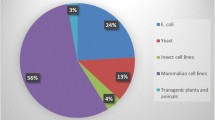Abstract
To establish an economical and reproducible method for the high-quality RNA extraction from pancreas, we isolated total RNA from rat pancreas with TRIzol® reagent and liquid nitrogen. In the initial stage, we optimized three influential factors, the way to homogenize pancreas, the time to collect the pancreatic tissue from animals, and the weight of the pancreatic tissue in 1 ml of TRIzol® reagent. The RNA quality was determined by detecting total RNA content and its absorbance at 260/280 nm wavelength, visualizing RNA in non-denatured agarose gel and performing RT-PCR of pancreas-specific genes. The A 260/A 280 ratio of the total RNA extracted by grinding 20–30 mg of rat pancreatic tissue removed from the rats in liquid nitrogen within 1 min and then immersed in 1 ml of the TRIzol® Reagent was 1.75–1.89, and the ratio of 28S/18S ribosomal RNA bands was more than 1.8. Furthermore, full length of Pdx1 open-reading frame was amplified with RNA extracted from the grinding group rather than from the conventional group. The RT-PCR products of pancreas-specific genes from both exocrine and endocrine parts of pancreas were successfully derived from the extracted RNA. The results suggested that we successfully provided an economical, fast, and reproducible method to obtain the high-quality and intact RNA from rat pancreas with TRIzol® Reagent and liquid nitrogen.




Similar content being viewed by others
References
Cox, R. A. (1968). Methods in Enzymology, 12, 120–129. doi:10.1016/0076-6879(67)12123-X.
Chirgwin, J. M., Przybyla, A. E., MacDonald, R. J., & Rutter, W. J. (1979). Biochemistry, 18, 5294–5299. doi:10.1021/bi00591a005.
Chomczynski, P., & Sacchi, N. (1987). Analytical Biochemistry, 162, 156–159. doi:10.1016/0003-2697(87)90021-2.
Chomczynski, P., & Sacchi, N. (2006). Nature Protocols, 1, 581–585. doi:10.1038/nprot.2006.83.
Beintema, J. J., Campagne, R. N., & Gruber, M. (1973). Biochimica et Biophysica Acta, 310, 148–160.
Mutter, G. L., Zahrieh, D., Liu, C., Neuberg, D., Finkelstein, D., Baker, H. E., et al. (2004). BMC Genomics, 5, 88. doi:10.1186/1471-2164-5-88.
Mullin, A. E., Soukatcheva, G., Verchere, C. B., & Chantler, J. K. (2006). BioTechniques, 40, 617–621.
Kiba, T., Kintaka, Y., Nakada, E., Suzuki, Y., Inoue, S., & Ishigaki, Y. (2007). Pancreas, 35, 98–100. doi:10.1097/01.mpa.0000278690.93930.b6.
Evans, R., & Kamdar, S. J. (1990). BioTechniques, 8, 357–360.
Peirson, S. N., & Butler, J. N. (2007). Methods in Molecular Biology (Clifton, N.J.), 362, 315–327. doi:10.1007/978-1-59745-257-1_22.
Salter, M. G., & Conlon, H. E. (2007). Methods in Molecular Biology (Clifton, N.J.), 362, 309–314. doi:10.1007/978-1-59745-257-1_21.
Chen, J., Byrne, G. E. Jr., & Lossos, I. S. (2007). Diagnostic Molecular Pathology, 16, 61–72. doi:10.1097/PDM.0b013e31802f0804.
Xiang, X., Qiu, D., Hegele, R. D., & Tan, W. C. (2001). Journal of Virological Methods, 94, 129–135. doi:10.1016/S0166-0934(01)00284-1.
Gill, S. S., Aubin, R. A., Bura, C. A., Curran, I. H., & Matula, T. I. (1996). Molecular Biotechnology, 6, 359–362. doi:10.1007/BF02761714.
Wang, S. S., Sherman, M. E., Rader, J. S., Carreon, J., Schiffman, M., & Baker, C. C. (2006). Diagnostic Molecular Pathology, 15, 144–148. doi:10.1097/01.pdm.0000213460.53021.cd.
Dekairelle, A. F., Van der Vorst, S., Tombal, B., & Gala, J. L. (2007). Clinical Chemistry and Laboratory Medicine, 45, 1283–1287. doi:10.1515/CCLM.2007.281.
Bendayan, M., & Ito, S. (1979). The Journal of Histochemistry and Cytochemistry, 27, 1029–1034.
Urban, E., Zingery, A. A., Bundrant, T., Weser, E., & Ziegler, D. M. (1982). Journal of Pediatric Gastroenterology and Nutrition, 1, 267–272.
Potenza, N., Salvatore, V., Migliozzi, A., Martone, V., Nobile, V., & Russo, A. (2006). Nucleic Acids Research, 34, 2906–2913. doi:10.1093/nar/gkl368.
Acknowledgments
We are very grateful to Dr. Hongmin Li (School of Life Science, Northwest University, Xi’an, China) for her excellent technical assistance and to Mr. Muhanmude Shahzad for critical reading and linguistic correction of the manuscript.
Funding
The project was supported by the National Natural Science Foundation of China (No. 30400249, 30571725 and 30630058), the Shaanxi Province International Cooperational Foundation of China (No.2007-kw-06), and the Shaanxi Province Natural Science Foundation of China (No. 2004C256).
Conflict of interest
The authors declare no competing interests.
Author information
Authors and Affiliations
Corresponding author
Additional information
Dongmin Li and Wuchao Ren equally contributed to this work. Shemin Lu and Tianbao Song are co-corresponding author.
Rights and permissions
About this article
Cite this article
Li, D., Ren, W., Wang, X. et al. A Modified Method using TRIzol® Reagent and Liquid Nitrogen Produces High-Quality RNA from Rat Pancreas. Appl Biochem Biotechnol 158, 253–261 (2009). https://doi.org/10.1007/s12010-008-8391-0
Received:
Accepted:
Published:
Issue Date:
DOI: https://doi.org/10.1007/s12010-008-8391-0




